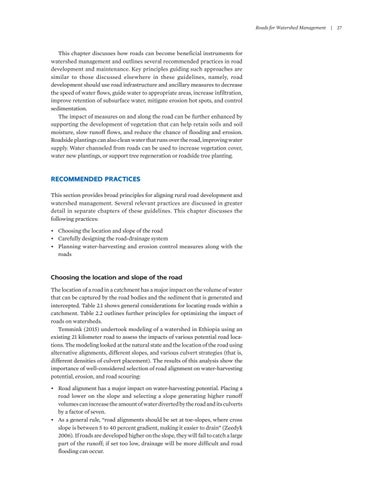Roads for Watershed Management | 27
This chapter discusses how roads can become beneficial instruments for watershed management and outlines several recommended practices in road development and maintenance. Key principles guiding such approaches are similar to those discussed elsewhere in these guidelines, namely, road development should use road infrastructure and ancillary measures to decrease the speed of water flows, guide water to appropriate areas, increase infiltration, improve retention of subsurface water, mitigate erosion hot spots, and control sedimentation. The impact of measures on and along the road can be further enhanced by supporting the development of vegetation that can help retain soils and soil moisture, slow runoff flows, and reduce the chance of flooding and erosion. Roadside plantings can also clean water that runs over the road, improving water supply. Water channeled from roads can be used to increase vegetation cover, water new plantings, or support tree regeneration or roadside tree planting.
RECOMMENDED PRACTICES This section provides broad principles for aligning rural road development and watershed management. Several relevant practices are discussed in greater detail in separate chapters of these guidelines. This chapter discusses the following practices: • Choosing the location and slope of the road • Carefully designing the road-drainage system • Planning water-harvesting and erosion control measures along with the roads
Choosing the location and slope of the road The location of a road in a catchment has a major impact on the volume of water that can be captured by the road bodies and the sediment that is generated and intercepted. Table 2.1 shows general considerations for locating roads within a catchment. Table 2.2 outlines further principles for optimizing the impact of roads on watersheds. Temmink (2015) undertook modeling of a watershed in Ethiopia using an existing 21 kilometer road to assess the impacts of various potential road locations. The modeling looked at the natural state and the location of the road using alternative alignments, different slopes, and various culvert strategies (that is, different densities of culvert placement). The results of this analysis show the importance of well-considered selection of road alignment on water-harvesting potential, erosion, and road scouring: • Road alignment has a major impact on water-harvesting potential. Placing a road lower on the slope and selecting a slope generating higher runoff volumes can increase the amount of water diverted by the road and its culverts by a factor of seven. • As a general rule, “road alignments should be set at toe-slopes, where cross slope is between 5 to 40 percent gradient, making it easier to drain” (Zeedyk 2006). If roads are developed higher on the slope, they will fail to catch a large part of the runoff; if set too low, drainage will be more difficult and road flooding can occur.







































